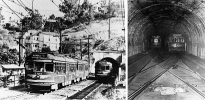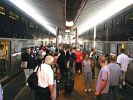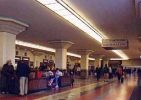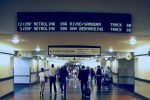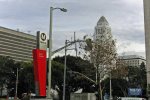| On July 3, 1873 Los Angeles transit history was made when D.V. Waldron was issued the first ever franchise to build a horsecar line from North Main St. and Alameda St. to the end of the line at South Main St. and Jefferson Blvd. However, Waldron forfeited his right to build the line so R.M. Widney who was issued the second ever franchise built the line, the first rail line in Los Angeles. It opened in the Spring of 1874. The fare was a dime. Widney's horsecar seated ten passengers and had a speed of about 12 mph. The line was two and a half miles long ending at 6th and Figueroa. During the next several decades more rail lines along with improvements will be built, paving the way for rail transit in Los Angeles. |
| By 1885 modern rapid transit technology arrived in the form of cablecars that slowly replaced the old fashioned horsecars. Nearly every major city street in Los Angeles had a cablecar line. This photo dated 1889 shows a cablecar on Fort Street (Broadway). |
| From 1904 thru the 1920s Los Angeles's rail transit system continued rapid growth, eventually operating trains on 1100 miles of track along with 2800 scheduled trains daily to become the world's largest rail mass transit system. This photo shows the opening day of Los Angeles's first subway in 1928. This view is of the west portal where the trains entered and exited the subway tunnels. The line ended at the Subway Terminal Building. The subway part of the transit system ran only under City Center West to avoid the already congested streets above. When service ended in 1955 the subway was carrying 100,000 passengers per day. Today the west portal sections of abandoned subway tunnels are occassionally used by film studios. |
| By the early 60's only one rail line remained, this 22 mile interurban line from Los Angeles to suburban Long Beach. This photo shows a southbound MTA train crossing the 710 freeway in the final week before the line was abandoned on April 8, 1961. Today a modern day MTA light rail line follows this same route. Meanwhile Los Angeles local streetcar service ended on March 31, 1963. For the next 27 years Los Angeles commuters were without any rail service and relied mainly on buses. |
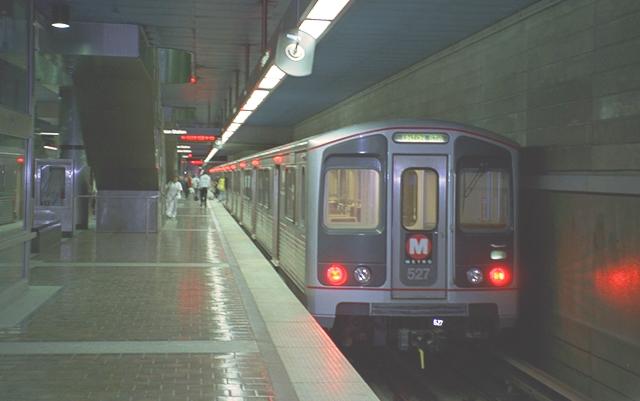 |
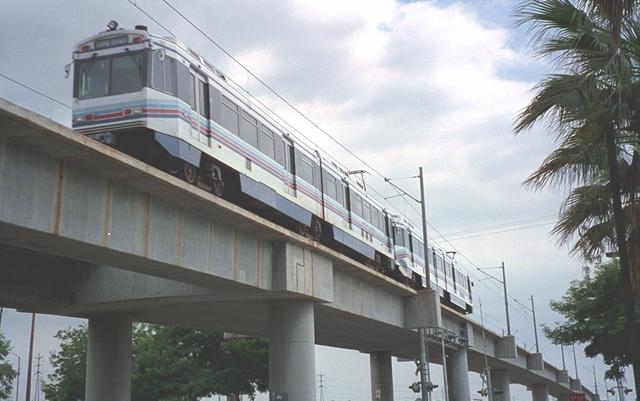 |
| Twenty-nine years after the last interurban rail line was abandoned and twenty-seven years after the last streetcar went out of service overwhelming public support brought rail transit back to Los Angeles in 1990 with Metro, a heavy rail subway and light rail system that's operated by the Los Angeles Metropolitan Transportation Authority. The public along with civic leaders realized that an all bus system did nothing to improve Los Angeles public transit. Slow moving buses only polluted the air as they chugged along and made traffic congestion worse. The twenty-seven year all bus 'experiment' failed miserably. Today 337,000 commuters ride Metro trains each day along 600 miles of track. |
| Like most cities across the country, Los Angeles became a car culture during the 50s and 60s. Today that has all but disappeared. The once popular drive-in theatres are now gone and drive-thru banking has mostly been phased out. Freeways are no longer the wide open highways they once were as traffic congestion happens any time of the day. With the rising cost of maintenance, gas and insurance, automobiles are becoming too expensive to own and operate. It's no wonder that more and more people are fed up with driving as they sell or leave their cars in the garage and are riding trains in Los Angeles once again. Currently there are two rail projects under construction, a seven mile Gold Line extension to the eastside and the new Expo Line to the westside. The Wilshire Purple Line subway is slated to be built as a subway to the beach extension. As of now the construction timeline is now in the development stage. |
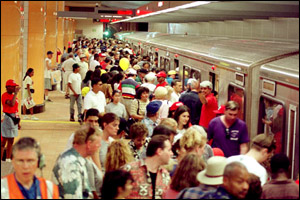 |
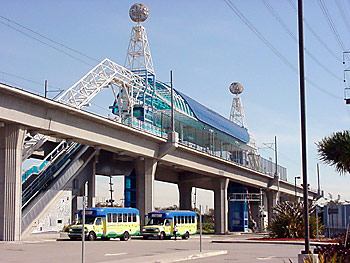 |
| Commuters and tourists getting on trains at a Metro Rail subway station in North Hollywood. |
| Stairway at the Aviation Station next to Los Angeles International Airport. |
| A Metro station in Redondo Beach. |
| RAIL MASS TRANSIT RETURNS TO LOS ANGELES IN 1990 AS METRO |
| Although the State of California has a car culture reputation, rail mass transit is no stranger to the City of Los Angeles. From 1874 to 1963 there have always been some type of fixed rail system in Los Angeles. During the 1920s and through much of the 1940s Los Angeles had the world's largest rail transit system with 1100 track miles, operated by the Pacific Electric Railway. These was not slow streetcar lines but rather high speed interurban rail lines with trains that ran on their own right of ways between Los Angeles and the suburbs. Back then most traveled by train and didn't own a car since they were expensive to own and operate. Many residential buildings were built without garages. After all, who needed a car and a garage when there was an excellent transportation system available. Then came the automobile, freeways, and the conspiracy. At first automobiles were too expensive for the average paycheck until the late 20s when car prices came down, sales went up and rail ridership started to decline. This was made even worse in the late 40s with the opening of Los Angeles's first freeways (called parkways then) which made traveling by car more convenient and enjoyable. However, these were not the only reasons for the demise of the Los Angeles rail system and rail systems around the world. A consortium of oil, rubber, General Motors and other companies bought up rail lines worldwide then replaced interurbans and streetcars with buses. By 1961 the last remaining interurban rail line in Los Angeles went out of service and in 1963 the last streetcar line shut down. |
| A Metro Rail train (left) and a Metro light rail train (right). The Los Angeles Metro system is among the largest and busiest in the nation. |
| Interurban trains ran on elevated tracks in City Center East until 1961 |
| Trains ran underground in City Center West until 1955 |
| LOS ANGELES METROPOLITAN TRANSPORTATION AUTHORITY One way fare to ride Los Angeles Metropolitan Transportation Authority (MTA) subways, light rail and buses is $1.25. Train and subway tokens: $1.25 each. Metro Pass: Day Pass $5 (great for tourists). Monthly Pass $62 (ideal for city commuters). The MTA provides local intercity public transportation. SOUTHERN CALIFORNIA REGIONAL RAIL AUTHORITY The Southern California Regional Rail Authority (SCRRA) Metrolink commuter trains have a different fare structure than the MTA. Fares are determined by distance traveled rather than a basic fare. This works best for commuters who live in outlying areas of Metropolitan Los Angeles and for tourists who need an easy way to get to such tourist attractions as Disneyland, Mission San Juan Capistrano, Del Mar, Legoland down in Carlsbad (with bus transfer) and the sunny resort beach city of Oceanside that are further outside Los Angeles city limits. The SCRRA provides interurban transportation to and from Los Angeles, Orange, San Bernardino, Riverside, and Ventura counties. |
| Meanwhile, an elevated terminal station for interurban trains was constructed on the east side of downtown behind the Pacific Electric Railways Building at Sixth and Main. After interurban service ended in 1961 the station was demolished and replaced with a huge three level bus terminal that encompassed an entire city block. The Southern California Rapid Transit District (SCRTD) and Greyhound Lines ran their buses out of this terminal. The former bus terminal building is still there and is now used as a retail and wholesale shopping center. |
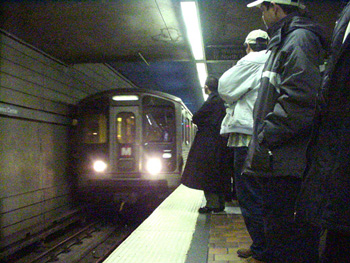 |
| Passengers ready to board a Metro Rail train at the multi-level Metro Center Station in the Financial District. This station which is served by three Metro lines is Los Angeles's second busiest train station. |
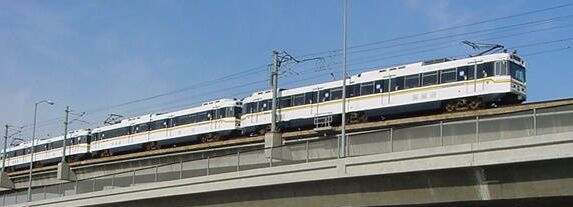 |
| A southbound Metro light rail train from Los Angeles to suburban Downtown Long Beach. |
| Metrolink trains and commuters at Los Angeles Union Passenger Terminal. Metrolink plays a key role in the Los Angeles region's bus and rail system by bringing commuters into the city from outlying areas. Commuters can then either walk or transfer to Metro buses and trains to their final destination. The successful commuter rail system operated by the Southern California Regional Rail Authority runs 142 daily trains on 507 miles of track on seven lines stretching as far north as Ventura, as far east as San Bernardino and as far south as Oceanside. |
| FUTURE OF RAIL TRANSIT IN LOS ANGELES |
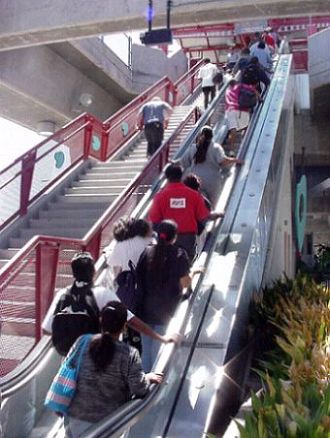 |
| METROLINK & AMTRAK |
| FROM YESTERDAY'S HORSECAR LINE TO TODAY'S WORLD CLASS METRO SYSTEM LOS ANGELES PUBLIC TRANSPORTATION HAS COME A LONG WAY |
| Metro System |
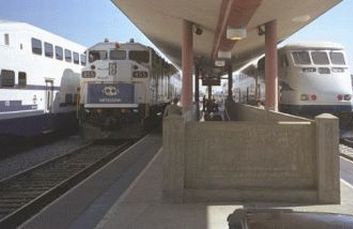 |
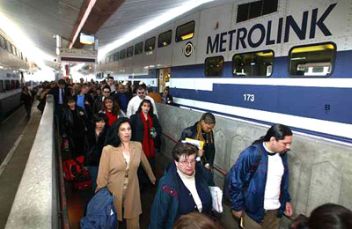 |
| Landmark Chinatown Station above the intersection of Spring and College streets on Chinatown's eastern fringe. |
 |
 |
 |
 |
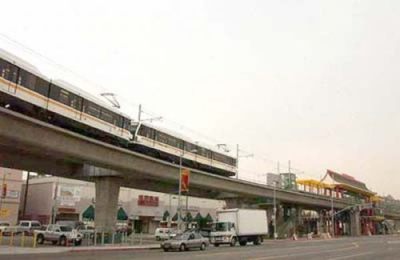 |
| Passengers departing Amtrak's Pacific Surfliner at Los Angeles Union Passenger Terminal station. Amtrak runs 28 daily scheduled trains to and from LAUPT. Many Amtrak trains are used as commuter rail. |
| Concourse at Los Angeles Union Passenger Terminal station. On an upper level above the main concourse level are boarding platforms for 12 tracks. Tracks 1 and 2 are now served by a light rail line while tracks 3 to 12 are used for Metrolink and Amtrack passenger service. On a lower level are platforms for two heavy rail subway lines, the Red and Purple lines. |
| Another area of this busy train station. This is where ticket agents (and fare vending machines) for Metrolink and Amtrack trains are located. On a lower level are fare vending machines for the Metro Rail subway system. More about Los Angeles Union Passenger Terminal station can be found in the ATTRACTIONS 2 section. |
| IMPORTANT NOTE: The Los Angeles Metropolitan Transportation Authority use only high platform rail cars. Elevators are located in all MTA subway and elevated stations for easy access to train platforms by the disabled and elderly. |
| PUBLIC TRANSIT AGENCIES SERVING THE GREATER LOS ANGELES METRO AREA |
| View of the city from the Chinatown Station platform. |
| Metro subway and light rail stations have signs that display the station name and are color coded to show which rail line serves that particular station. |
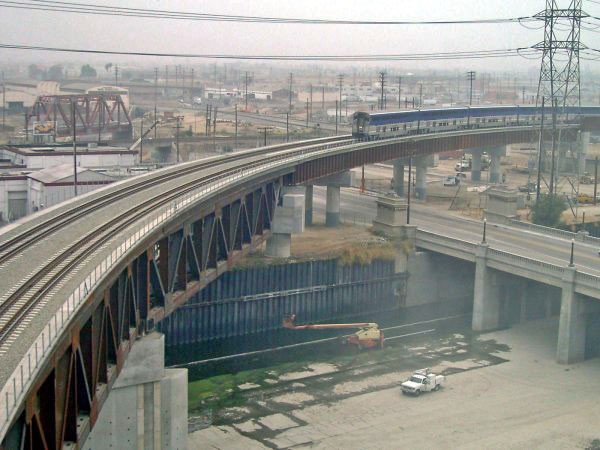 |
| A northbound Amtrak train from Orange County to Los Angeles. |
| Red Line (heavy rail subway) - City Center to Hollywood and the Valley Purple Line (heavy rail subway) - City Center to Wilshire Center and Korea Town Green Line (light rail) - Norwalk to South Los Angeles and the South Bay area Blue Line (light rail) - City Center to Compton and Downtown Long Beach Gold Line (light rail northbound) - City Center to Pasadena and the San Gabriel Valley Gold Line (light rail eastbound) - City Center to Boyle Heights and the Eastside Metrolink - City Center to San Bernardino, Riverside, Orange, Ventura counties and Oceanside |
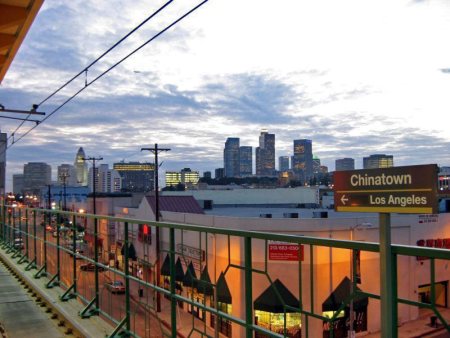 |




